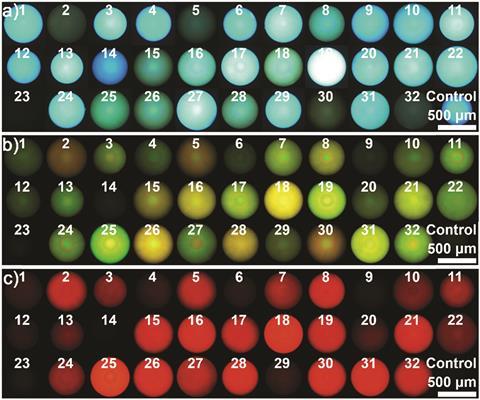System that exploits non-covalent interactions between ionic liquid moieties and carbohydrates could have multiple real-world applications
A team in China has developed a new sensing platform for carbohydrate analysis. Using polymerised ionic liquids doped with luminogens they made photonic spheres that can distinguish between 32 different saccharides.
Detecting saccharides is important for a number of reasons – produced by certain bacteria, they can be an indicator of contamination or spoilage in food. Additionally, detecting saccharides in human serum can indicate the presence of disease. Unfortunately, the structural complexity and subtle regio- and stereochemical differences between carbohydrates present a challenge.
Now, the way chemicals in food stimulate the human tongue to send response signals to specific parts of the brain that register flavour has inspired a new system. ‘To mimic this sensing mechanism, we developed a poly(ionic liquid) photonic sphere as an artificial tongue to distinguish different saccharides,’ says Guangtao Li of Tsinghua University, who led the work. After interacting with a saccharide, aggregation-induced emission luminogens doped onto the poly(ionic liquid) sphere produce a distinct optical response, depending on the analyte. The photonic and fluorescence properties of luminogens allow for drastic colour changes in the presence of different saccharides.
The use of ionic liquids in this way is unique – complex macrocycles or boronic acids are the traditional compounds used for saccharide detection. Boronic acid-based platforms are very pH sensitive and often require a high pH to work. The new platform is stable between pH 4–9.
The system exploits abundant non-covalent interactions between the poly(ionic liquid)s and saccharides. Using just one sphere, Li’s team were able to separate 23 different saccharides, including glucose, fructose, trehalose and acarbose, and using two spheres together expanded the detection range to 32 saccharides. A computer handled the responses to generate diagnostic response patterns.

Mindy Levine, an expert on carbohydrate analysis from the University of Rhode Island, US, says ‘the fact that so many saccharides are detectable using one platform is outstanding, as the variety of naturally occurring and synthetically available saccharides can introduce complexity and lead to false conclusions if some saccharides are not detected.’
To test their platform, Li’s team used it to distinguish between brands of sugary drink. However, in the future, they hope to collect the responsive fingerprints of all commonly available carbohydrates to build a reference database. As all carbohydrates have a distinct fingerprint, Li says the data will ‘enable the quick and unambiguous identification of unknown carbohydrate compounds’.











No comments yet